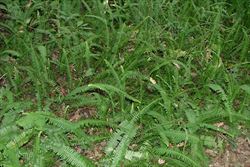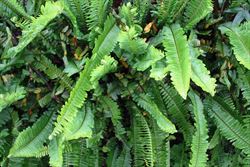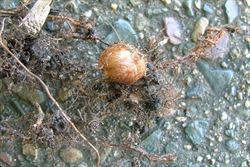Click on images to enlarge

infestation (Photo: Sheldon Navie)

infestation (Photo: Sheldon Navie)

habit (Photo: Sheldon Navie)

close-up of the spore clusters, which are arranged in two rows (Photo: Sheldon Navie)

close-up of the creeping underground stems, with a single fleshy round tuber (Photo: Sheldon Navie)

the very similar Boston fern, Nephrolepis exaltata (Photo: Sheldon Navie)
Scientific Name
Nephrolepis cordifolia (L.) Presl
Synonyms
Aspidium cordifolium Sw.Aspidium cordifolium Sw. var. tambourinense (Domin) F.M. BaileyAspidium tuberosum Bory ex Willd.Aspidium volubile (Sm.) F.M. Bailey var. cavernicolum (Domin) F.M. BaileyNephrolepis auriculata (L.) TrimenNephrolepis cordifolia (L.) Presl var. tambourinensis DominNephrolepis radicans (Burm. f.) Kuhn var. cavernicola DominNephrolepis tuberosa (Bory ex Willd.) PreslPolypodium cordifolium L.
Family
Davalliaceae (New South Wales, Victoria, Western Australia and the Northern Territory)Nephrolepidaceae (Queensland)
Common Names
erect sword fern, fishbone fern, herringbone fern, ladder fern, narrow swordfern, southern sword fern, sword fern, tuber fern, tuberous sword fern
Origin
The exact native range of this species is obscure, partly because it has often been confused with other similar species. It is thought to be native to many tropical regions of the world (i.e. pan-tropical), including some parts of northern Australia (i.e. the coastal districts of eastern Queensland and some parts of north-eastern New South Wales).
Cultivation
This species is widely and commonly cultivated in gardens and amenity areas, particularly in eastern and southern Australia.
Naturalised Distribution
Naturalised in Victoria, in the coastal districts of south-western Western Australia, on Norfolk Island and beyond its native range in the coastal districts of central New South Wales. Possibly also naturalised on Lord Howe Island and regarded as being naturalised in some habitats and areas that are outside its natural distribution in south-eastern Queensland and north-eastern New South Wales.
Widely naturalised overseas in Africa, temperate Asia, New Zealand and south-eastern USA (i.e. Florida, Alabama and Georgia).
Habitat
In its natural environment, fishbone fern (Nephrolepis cordifolia) is usually found growing in rocky areas, on rainforest margins, or as an epiphyte on palm trees in the wetter parts of tropical and sub-tropical Australia.
It is mainly a weed of parks, gardens, roadsides, fence lines, disturbed sites, waste areas, railway lines, suburban bushland, riparian areas and coastal environs in sub-tropical and warmer temperate regions.
Habit
A fern with upright (i.e. erect) or drooping fronds usually growing about 50 cm tall, but occasionally reaching up to 1 m in height.
Distinguishing Features
- a fern with upright or drooping fronds usually up to 50 cm long.
- this species often produces distinctive round tubers on its creeping underground stems.
- its 'leaves' are divided into numerous alternatively arranged narrow 'leaflets' (10-35 mm long and 4-11 mm wide).
- the lower parts of the 'leaflets' are usually somewhat overlapped and slightly lobed on one side, while their tips are relatively broad and somewhat rounded.
- its brown spores are produced is small clusters midway between the centre and the margin of the undersides of the 'leaflets'.
Stems and Leaves
It forms a network of creeping stems (i.e. rhizomes and/or stolons) and usually develops some fleshy rounded (i.e. spherical) tubers (about 15 mm across). The creeping stems (i.e. rhizomes and stolons) and lower parts of the 'leaves' (i.e. stipes) are densely covered in glossy brown elongated (i.e. linear-lanceolate) scales.
Its upright 'leaves' (i.e. fronds) have a brownish-coloured stalk (i.e. stipe) up to 15 cm long and are divided into numerous alternatively arranged narrow ‘leaflets’ (i.e. pinnae). These ‘leaflets’ (usually 10-35 mm long and 4-11 mm wide, but rarely to 6 cm long) have irregularly and often finely scalloped (i.e. crenate or crenulate) margins and are usually hairless (i.e. glabrous). Their tips (i.e. apices) are relatively broad and somewhat rounded (i.e. obtuse) and their bases are usually somewhat overlapping and slightly lobed on one side. Fronds tend to be dull green in shaded areas and lighter green or yellowish-green when growing in a sunny position.
Flowers and Fruit
Numerous brown, round to kidney-shaped (i.e. reniform), spots will be evident on the undersides of mature fronds. These are the reproductive structures of this species (i.e. sori) and contain the numerous spores. They are partially protected by a tiny kidney-shaped flap of 'leaf' tissue (i.e. a reniform indusium). These reproductive structures (i.e. sori) are arranged in two rows on the undersides of the 'leaflets' (i.e. pinnae), each row being midway between the margin and the centre (i.e. midrib).
Reproduction and Dispersal
This species reproduces by spores and vegetatively via underground stems (i.e. rhizomes) and often also by fleshy underground tubers.
Spores are most commonly spread by wind and water, while the rhizomes, tubers and spores are most often dispersed to new areas in dumped garden waste.
Environmental Impact
Fishbone fern (Nephrolepis cordifolia) is regarded as an environmental weed in New South Wales and Queensland.
Legislation
Not declared or considered noxious by any state government authorities.
Management
For information on the management of this species see the following resources:
- the Randwick City Council environmental weeds profile on this species, which is available online at http://www.randwick.nsw.gov.au.
- the Mosman Municipal Council weed profile on this species, which is available online at http://www.mosman.nsw.gov.au.
- the Sutherland Shire Council weed fact on this species, which is available online at http://www.sutherland.nsw.gov.au.
Similar Species
Fishbone fern (Nephrolepis cordifolia) is very similar to several other native ferns (Nephrolepis spp., Pellaea spp., Blechnum spp. and Doodia spp.). The sword ferns (Nephrolepis spp.) are mostly confined to the forests and gorges of northern Australia, and can often be distinguished by their larger fronds with pointed 'leaflets' (i.e. pinnae) up to 10 cm or more long. The sickle ferns (Pellaea spp.) and water ferns (Blechnum spp.) have linear reproductive structures (i.e. sori), often along the margins of their entire 'leaflets' (i.e. pinnae), while the rasp ferns (Doodia spp.) have pointed 'leaflets' (i.e. pinnae) with sharply toothed (i.e. serrate or serrulate) margins.
Fishbone fern (Nephrolepis cordifolia) is also very similar and the introduced and cultivated Boston fern (Nephrolepis exaltata). These two species can be distinguished by the following minor differences:
- fishbone fern (Nephrolepis cordifolia) has fronds with 'leaflets' (i.e. pinnae) that overlap at their bases. The tiny flaps of tissue (i.e. indusia) covering its reproductive structures (i.e. sori) are broadly kidney-shaped (i.e. reniform). It often produces round, fleshy, underground tubers.
- Boston fern (Nephrolepis exaltata) has fronds with 'leaflets' (i.e. pinnae) that are not overlapping. The tiny flaps of tissue (i.e. indusia) covering its reproductive structures (i.e. sori) are almost circular (i.e. sub-orbicular). It does not produce any underground tubers.

